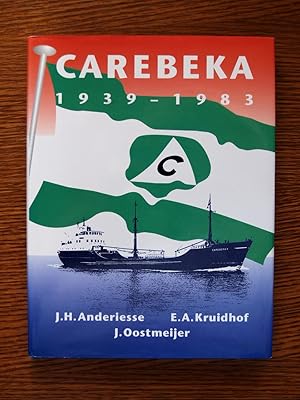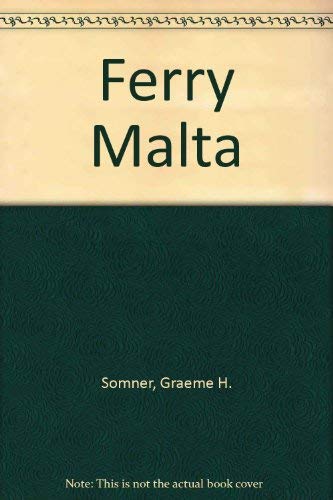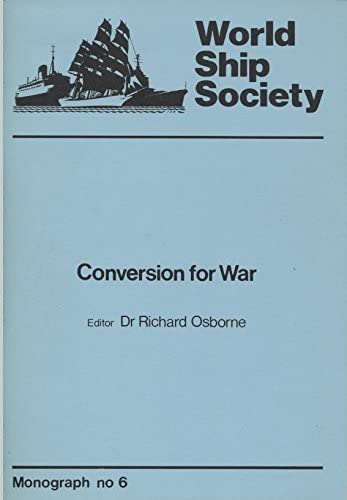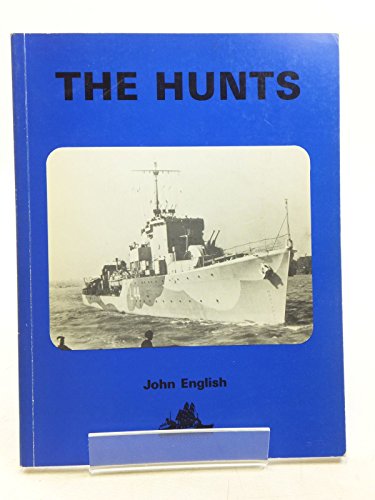world ship society cumbria england (4 results)
Product Type
- All Product Types
- Books (4)
- Magazines & Periodicals
- Comics
- Sheet Music
- Art, Prints & Posters
- Photographs
- Maps
-
Manuscripts &
Paper Collectibles
Condition
- All Conditions
- New
- Used
Binding
Collectible Attributes
- First Edition (3)
- Signed
- Dust Jacket (1)
- Seller-Supplied Images (1)
- Not Printed On Demand
Seller Location
Seller Rating
-
Carebeka 1939-1983
Published by World Ship Society, Cumbria, England, 1996
ISBN 10: 0905617789ISBN 13: 9780905617787
Seller: Terry Blowfield, Norwich, NORFO, United Kingdom
Book First Edition
Hardcover. Condition: Very Good. Dust Jacket Condition: Near Fine. 1st Edition. Published by World Ship Society of Cumbria, England in 1996. Hardcover. 1st edition, 2nd impression. Book is written in Dutch and English. Book condition: Very good. An ex-library book with stamps inside. Would have rated higher if not for the one library stamp. Inside the pages are in good order. Dust Jacket condition: Near Fine. Jacket intact. See photograph. Dims: 250mm x 190mm x 20mm. 240 pages. Book relates to the coastal Dutch shipping industry. Full of information about the coastal books and information on each of them.
-
Ferry Malta, Il-Vapuri Ta Ghawdex
Published by World Ship Society, Kendal, Cumbria, England, 1982
ISBN 10: 0905617193ISBN 13: 9780905617190
Seller: Ryde Bookshop Ltd, Isle of Wight, United Kingdom
Book
Soft cover. Condition: Good. Illustrated, stapled booklet.Light handling wear including a little rubbing on the spine.
-
Conversion for War; Monograph no 6
Published by World Ship Society, Kendel, Cumbria, England, 1983
ISBN 10: 0905617258ISBN 13: 9780905617251
Seller: Ground Zero Books, Ltd., Silver Spring, MD, U.S.A.
Book First Edition
Wraps. Condition: Good. Presumed First Edition, First printing. 84 pages. Illustrations. Sources. Index of Ships. Minor cover and page wear and soiling. In addition to the editor, other contributors include: Arnold Hague, Roger Nailer, and Aldo Fraccaroli. Richard Osborne is a retired lecturer in Pharmacology who was born in Portsmouth in 1948 and awarded a Ph.D. in Neurochemistry by Imperial College in 1974. He has always had a keen interest in ships joining the World Ship Society in 1962 and serving as its Chairman from 2000 to 2012. The World Ship Society (WSS) is an international society devoted to maritime and naval history. Founded in 1946 as Ship News Club in order to distribute shipping information to correspondents, the society now has thousands of members in dozens of branches across the world. It publishes the monthly magazine Marine News and the quarterly magazine Warships for its membership. This is a booklet recording the origins, functions, development, armament and service histories of some of the most important 'auxiliary' war ships of World War II. Concentrates on those of the Royal Navy. Small chapter an Italian AMC's. Contains many ship photos, merchant ships used as naval auxiliaries during WWII, many hitherto unpublished photos.
-
The Hunts; A history of the design, development and careers of the 86 destroyers of this class built for the Royal and Allied Navies during World War II
Published by World Ship Society, Cumbria, England, 1987
ISBN 10: 0905617444ISBN 13: 9780905617442
Seller: Ground Zero Books, Ltd., Silver Spring, MD, U.S.A.
Book First Edition
Trade paperback. Condition: Good. First Edition, Presumed First Printing. 108 pages. Includes illustrations, Dedication and publisher, Contents, Acknowledgments and Notes, and Genesis. Also includes Construction, Deployment, Analysis of Losses, Post War Service, Review of the Hunts, Ship Histories, List of Pendant Numbers, Endpiece, and Plan of a Type 1 Hunt, a large folding illustration of H. M.S. Cattistock at back cover. Cover has some wear and soiling. The Hunt class was a class of escort destroyer of the Royal Navy. The first vessels were ordered early in 1939, and the class saw extensive service in the Second World War, particularly on the British east coast and Mediterranean convoys. They were named after British fox hunts. The modern Hunt-class GRP hulled mine countermeasure vessels maintain the Hunt names lineage in the Royal Navy. The Royal Navy had identified the need for two types of destroyer: larger vessels with heavy gun and torpedo armaments for fleet work and another type for escort duties. The escort vessels forsook the heavy armament and some of the speed of the fleet type to reduce unit cost and better suit mass production and the conditions. This fast escort vessel" was later classified as an "escort destroyer". Eighty-six Hunts were completed, of which 72 were commissioned into the Royal Navy and the remaining 14 were transferred to allied navies; Bolebrooke, Border, Catterick, Hatherleigh, Modbury, Bramham and Hursley to the Greek Royal Hellenic Navy, Bedale, Oakley and Silverton to the Free Polish Navy, Glaisdale, Eskdale and Badsworth to the Royal Norwegian Navy and Haldon to the Free French Navy. The Hunts were modeled on the 1938 escort sloop Bittern, a 262-foot (80 m) ship of 1,190 tons with 3,300 shp (2,500 kW) on geared turbines for 18¾ knots and an armament of three twin Mark XIX mounts for the QF 4-inch (102 mm) gun Mark XVI. The guns were controlled by a Fuze Keeping Clock AA fire control computer when engaging aircraft. The Hunt class was to ship the same armament, plus a quadruple QF 2 pounder mount Mark VII on a hull of the same length but with 8 feet (2 m) less beam and installed power raised to 19,000 shp (14,000 kW) to give 27 knots (50 km/h). The first twenty were ordered in March and April 1939. They were constructed to Admiralty standards, as were contemporary destroyers, unlike the frigates, which conformed much more to mercantile practice. Clearly the Hunts posed a major design challenge. They would be too short and narrow and of insufficient range for open ocean work, being restricted to the North Sea and Mediterranean Sea. This sacrifice was accepted to give any chance of meeting the requirements. The demanding specifications in an overworked Admiralty design department resulted in a major design miscalculation. When the detailed calculations were done the center of gravity was lower than expected and the beam was increased. As the first ships were being completed it was found that the design was as much as 70 tons overweight, top heavy, leaving them dangerously deficient in stability. The first twenty ships were so far advanced in construction that it was necessary to remove the 'X' 4-inch gun mount and add 50 tons of permanent ballast. These ships became the Type I group, and had the multiple 2-pounder gun relocated from behind the funnel to the more advantageous 'X' position. The design deficiency of the Type I was rectified by splitting the hulls lengthwise and adding a 2½ foot section, increasing the beam to 31 ft 6 in and the margin of stability sufficiently for the designed armament to be shipped. These ships became the Type II group, and also had a revised design of bridge with the compass platform extending forwards to the wheelhouse face. Under the 1939 Emergency War Program 36 more Hunts had been ordered; three of these were completed to the original (Type I) design. Depth charge stowage could also be increased from 40 in the Type I to 110. For the 1940 building program, torpedoes were deemed necessary. The next 27 ships were completed to a revised design, the Type III group, and were intended specifically for Mediterranean work. They sacrificed 'Y' gun for a pair of 21-inch torpedo tubes amidships, the searchlight being displaced to the aft shelter deck as a result. The Type III Hunts could be easily identified as they had a straight funnel with a sloping top and the foremast had no rake. Fourteen of them had their stabilizer fins removed (or not fitted in the first place) and the space used for extra fuel oil. The last two Hunts came from an independent lineage and were built to a private design that had been prepared pre-war by John I. Thornycroft & Company. Submitted to the Admiralty and rejected in 1938, a modified design had been accepted in 1940. They were known as the Type IV. They had a novel hull design, with a U-shaped forward section with a distinctive double knuckle and a full center section with a square turn at the bilge. This form was intended to increase low-speed efficiency and reduce rolling without the need for ballast or stabilizers to improve the ships as gun platforms; testing showed an 8% increase in steaming efficiency at 20 knots (37 km/h) for a 2% loss full ahead. Other features included a long fo'c'sle stretching for most of the length of the ship, which increased internal accommodation space (the lack of which was a perennial problem in wartime ships with enlarged crews) and allowed the crew to fight the ship almost completely under cover. As a result, 'X' gun was now at the fo'c'sle deck level rather than on a raised shelter deck. The design was large enough to carry a triple set of torpedoes, but as they too were at fo'c'sle deck level the training apparatus had to be remotely mounted a deck below. Armament was completed by a pair of single 20 mm Oerlikon guns in the bridge wings and a pair of power operated twin 0.5-inch Vickers machine guns amidships, quickly discovered to be ineffective and replaced by the Mark V twin mounting for the Oerlikon gun. The level of protectio.





